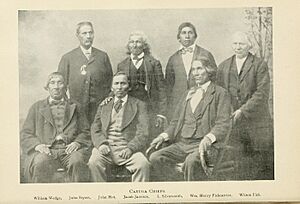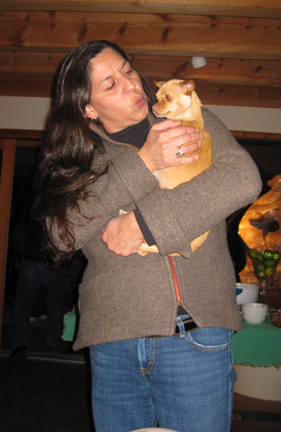Cayuga people facts for kids

Cayuga leaders c. 1901
|
|
| Total population | |
|---|---|
| 12,000+ (450 in New York; 5,000 in Oklahoma; 7,000 in Ontario) |
|
| Regions with significant populations | |
| Ontario (Canada) New York and Oklahoma (United States) |
|
| Languages | |
| Cayuga, English, other Iroquoian languages | |
| Religion | |
| Longhouse religion, Christian denominations | |
| Related ethnic groups | |
| Seneca Nation, Onondaga Nation, Oneida Nation, Mohawk Nation, Tuscarora Nation, other Iroquoian peoples |
The Cayuga (pronounced like "kay-YOO-gah") are an important group of Native Americans from New York. Their own name for themselves is Gayogo̱hó꞉nǫʼ, which means "People of the Great Swamp." They are one of the five original nations that formed the Haudenosaunee (also known as the Iroquois Confederacy).
The Cayuga's traditional homeland is in the Finger Lakes area. This is in central New York, around Cayuga Lake. They lived between their Iroquois neighbors: the Onondaga to the east and the Seneca to the west. Today, Cayuga people live in different places. Many are part of the Six Nations of the Grand River First Nation in Ontario, Canada. Others are in the United States, belonging to the Cayuga Nation of New York and the Seneca-Cayuga Tribe of Oklahoma.
Contents
History of the Cayuga People
During the American Revolution, the Cayuga had a complex role. Some Cayuga warriors fought with the British. They hoped this would stop colonists from taking their lands. Other Cayuga fought with the Thirteen Colonies, or stayed out of the war completely.
In 1778, some Iroquois groups, often with British supporters, attacked frontier settlements. These attacks happened from Connecticut to New York and into Pennsylvania. The American government saw these as serious problems.
The Sullivan Expedition
In 1779, General George Washington ordered a military campaign. General John Sullivan and James Clinton led this mission. It was called the Sullivan Expedition. Its goal was to stop the Iroquois Confederacy from attacking American forces.
The expedition involved 6,200 soldiers. They destroyed 40 to 50 Iroquois villages, including major Cayuga towns. Among these were Cayuga Castle and Chonodote (Peachtown). The soldiers also destroyed crops and winter food supplies. This was meant to force the Iroquois people out of their lands. Many survivors fled to other Iroquois tribes or to Canada. The British gave land in Canada to those who had stayed loyal to them.
After the Revolution
After the war, the Central New York Military Tract was created. This land was given to American soldiers as a reward. It first included a Cayuga reservation near Cayuga Lake. However, this reservation was later given up in a treaty with New York state.
Some Seneca and Cayuga people had moved west earlier. They went to the Ohio Country in what is now Ohio, West Virginia, and Pennsylvania. These groups became known as the Mingo. After the Sullivan Campaign, more Cayuga joined them. By 1831, many Native Americans in the eastern U.S. were forced to move. They went to the Indian Territory, which is now Oklahoma. The Seneca-Cayuga Tribe of Oklahoma is a recognized tribe today.
The Pickering Treaty
On November 11, 1794, the Cayuga Nation in New York signed the Pickering Treaty. This treaty was with the United States. The Cayuga and other Haudenosaunee nations gave up much of their land in New York. They were forced to do this because they had been allies of the defeated British.
This was the second treaty the United States ever signed. It recognized the Haudenosaunee nations as independent. The Pickering Treaty is still a legal document today. The U.S. government still sends a special gift of muslin fabric to the nations each year.
New York state later made more treaties with the tribes. But these treaties were not approved by the U.S. Senate. This meant they were not legal, because only the U.S. government could make treaties with Native American nations. New York quickly sold off millions of acres of former Iroquois land. This was done to encourage new settlements. Many new settlers came to New York from New England, Britain, and France.
Cayuga Bands Today

There are three main groups, or bands, of Cayuga people today. The two largest groups are the Lower Cayuga and Upper Cayuga. They live in Ontario, Canada, at the Six Nations of the Grand River reserve. This reserve is recognized by the Canadian government.
The third group is in the United States. It includes two federally recognized tribes:
- The Cayuga Nation of New York in Seneca Falls, New York.
- The Seneca-Cayuga Tribe of Oklahoma.
The Cayuga Nation of New York does not have its own reservation. Its members have often lived among the Seneca Nation on their reservation. Since the late 1900s, they have bought some land back in their traditional homeland.
Land Claims
The Cayuga Nation of New York started a lawsuit on November 19, 1980. They wanted money and land back that New York state had taken. New York had made land deals with the Cayuga Nation after the American Revolutionary War. These deals were illegal because the state did not have the power to make them. Only the U.S. government could make legal agreements with the Haudenosaunee. This was stated in the Treaty of Canandaigua.
In 1981, the Seneca-Cayuga Tribe of Oklahoma joined the lawsuit. After many years, a jury trial was held in 2000. The jury decided in favor of the Cayuga nations. They said the state owed about $36.9 million in damages. In 2001, the court added more money for interest, making the total about $247.9 million.
Both sides appealed this decision. In 2005, a higher court reversed the judgment. The court said the Cayuga had waited too long to bring their case. This legal idea is called laches. The Cayuga Nation of New York asked the Supreme Court of the United States to review this. But the Supreme Court refused in 2006.
Reclaiming Ancestral Lands
Even though the lawsuit was lost, the Cayuga Nation has been buying back land. On July 17, 1996, they bought 14 acres in Seneca Falls. This was inside their original land claim area. A special ceremony was held in 1997. Members from all the Iroquois Confederacy nations were there. They planted a pine tree as a symbol that the Cayuga people are still strong and returning home.
In December 2005, the S.H.A.R.E. Farm was given to the Cayuga Nation. This 70-acre farm in Aurora, New York, was bought by U.S. citizens. They then signed it over to the Cayuga. This was the first property the Cayuga Nation had owned in their ancestral homeland in over 200 years. The Cayuga are now working on projects there. These include planting native crops, growing herbs, and saving seeds.
Current Population
In 1995, there were about 450 Cayuga members in New York. In the 21st century, there are about 4,892 combined members of the Cayuga-Seneca Nation in Oklahoma.
It is hard to know the exact total number of Iroquois people. In 1995, about 45,000 Iroquois lived in Canada. Most were in Ontario. In the United States, about 30,000 people were enrolled members of Iroquois tribes in 1995. The 2000 U.S. Census showed that 45,217 people said they were only Iroquois. Also, 80,822 people said they had Iroquois ancestry.
| Location | Seneca | Cayuga | Onondaga | Tuscarora | Oneida | Mohawk | Combined | Totals |
|---|---|---|---|---|---|---|---|---|
| Ontario | 3,970 | 14,051 | 17,6031 | 39,624 | ||||
| Quebec | 9,631 | 9,631 | ||||||
| New York | 7581 | 448 | 1596 | 1200 | 1,109 | 5,632 | 17,566 | |
| Wisconsin | 10,309 | 10,309 | ||||||
| Oklahoma | 4,8922 | 4,892 | ||||||
| Totals | 7581 | 448 | 1596 | 1200 | 15,338 | 29,314 | 22,495 | 82,022 |
1 Six Nations of the Grand River Territory.
2 Seneca-Cayuga Tribe of Oklahoma.
Notable Cayuga People
- George Edward Bomberry, a doctor and the first Indigenous graduate of McGill University.
- Jenna Clause, an actress.
- Gary Farmer, an actor.
- Annessa Hartman, an American politician.
- Ourehouare, a tribal leader.
- Robbie Robertson, a Canadian musician and lead singer of The Band.
See also
 In Spanish: Cayuga para niños
In Spanish: Cayuga para niños

